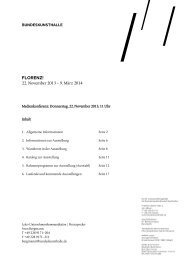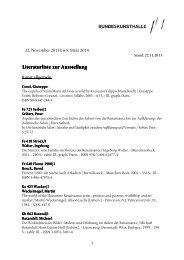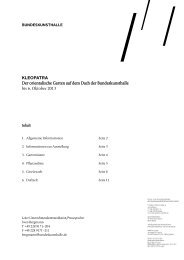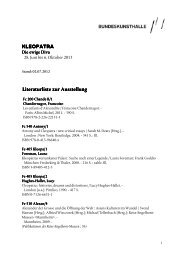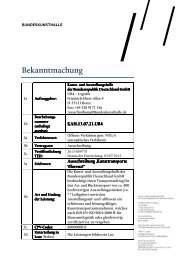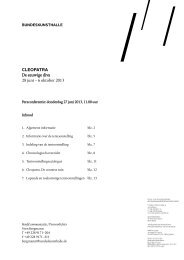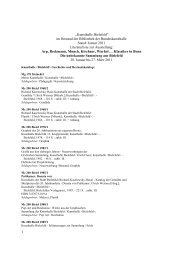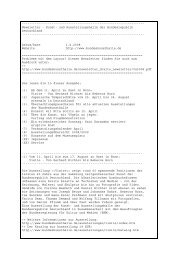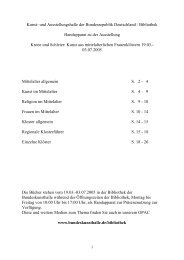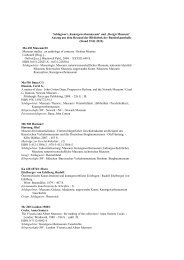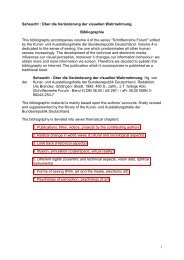Peoples through space and time Archaeology in Germany 09.05 ...
Peoples through space and time Archaeology in Germany 09.05 ...
Peoples through space and time Archaeology in Germany 09.05 ...
Create successful ePaper yourself
Turn your PDF publications into a flip-book with our unique Google optimized e-Paper software.
The rich spectrum of archaeological f<strong>in</strong>ds from the late Celtic <strong>and</strong> early Roman era, as well as the<br />
discovery of a Celtic fortified wall of the type murus gallicus, prove that the Martberg was not only the<br />
site of a shr<strong>in</strong>e, but that the entire facility must have been a Celtic hill fort (Oppida). In Roman <strong>time</strong>s the<br />
Oppida was left open, the central Celtic cult area, however, was reta<strong>in</strong>ed <strong>and</strong> even augmented by stone<br />
<strong>in</strong> the 1 st century A.D.<br />
Archaeological research was able to uncover for the first <strong>time</strong> a more differentiated underst<strong>and</strong><strong>in</strong>g of<br />
how a cult area orig<strong>in</strong>ated, developed <strong>and</strong> was structured over an unbroken period between the 1 st<br />
century B.C. until the 5 th century A.D.<br />
On the Threshold to High Culture<br />
From an archaeological perspective, the entire late Celtic region between France <strong>and</strong> Hungary presents a<br />
predom<strong>in</strong>antly homogenous picture, characterized by the so-called Oppida Civilization. It is<br />
dist<strong>in</strong>guished by re<strong>in</strong>forced cities accord<strong>in</strong>g to the Mediterranean model, luxury <strong>and</strong> everyday goods <strong>in</strong><br />
series production, foreign trade <strong>and</strong> co<strong>in</strong>age, as well as a conformity <strong>in</strong> cult practices <strong>and</strong> religious<br />
ideas.<br />
Celtic culture <strong>in</strong> Southern <strong>Germany</strong> decl<strong>in</strong>ed gradually, its decl<strong>in</strong>e is considered to have been brought<br />
about by the <strong>in</strong>vasion of Germanic tribes from the low mounta<strong>in</strong>s <strong>in</strong> the 1 st century B.C. Archaeological<br />
research has proven that, <strong>in</strong> comparison, the region west of the Rh<strong>in</strong>e was cont<strong>in</strong>uously populated from<br />
the Celtic to Roman era.<br />
11 b<br />
Archaeological Aerial Photography<br />
When <strong>in</strong> 1987 an aerial reconnaissance plane flew over the Glauberg <strong>and</strong> discovered a large circular<br />
ditch, it was the first archaeological h<strong>in</strong>t of a monumental ensemble of European rank.<br />
As <strong>in</strong> the area around Glauberg, aerial reconnaissance can systematically exam<strong>in</strong>e large tracts of l<strong>and</strong><br />
for past traces of human settlement, <strong>and</strong> can record them <strong>in</strong> photographs. These traces are more or less<br />
evident on the ground accord<strong>in</strong>g to the year, ground humidity, light or vegetation density.<br />
The first co<strong>in</strong>cidental images were taken already before World War I, yet scheduled searches did not<br />
take place until the 1960s <strong>in</strong> the Rh<strong>in</strong>el<strong>and</strong>, <strong>and</strong> <strong>in</strong> most other states not until the 1970s. After the fall of<br />
the Berl<strong>in</strong> Wall, aerial surveys were also extended to Central <strong>and</strong> Eastern <strong>Germany</strong>. In just a matter of<br />
six years more than 50,000 photographs were taken <strong>and</strong> approximately 3200 new sites were identified <strong>in</strong><br />
Saxony-Anhalt.<br />
Geophysical Sens<strong>in</strong>g<br />
Geophysical sens<strong>in</strong>g allows a detailed view <strong>in</strong>to what is beneath the earth’s surface without hav<strong>in</strong>g to<br />
dig with a shovel. Wherever the ground has been disturbed by human activity, for example by digg<strong>in</strong>g<br />
graves, ditches or lay<strong>in</strong>g foundations, the physical properties of these sites change. These changes are<br />
picked up by highly sensitive tools <strong>and</strong> projected <strong>in</strong> the form of graphic images unto a screen.<br />
Methods of geophysical sens<strong>in</strong>g <strong>in</strong>clude, <strong>in</strong> particular, magnetic survey, electrical resistivity <strong>and</strong> ground<br />
penetrat<strong>in</strong>g radar. Apply<strong>in</strong>g several of these sens<strong>in</strong>g methods <strong>in</strong> comb<strong>in</strong>ation helps to ga<strong>in</strong> a deep<br />
<strong>in</strong>sight <strong>in</strong>to the archaeological site before the first hole has been dug. As a result, excavations can be<br />
planned more efficiently <strong>and</strong> precisely, <strong>and</strong> the exact boundaries of the archaeological site can be<br />
determ<strong>in</strong>ed.<br />
An excellent example for the implementation of magnetic survey at an archaeological site is the<br />
exam<strong>in</strong>ation of the area around Glauberg. As one of the biggest survey projects to have been <strong>in</strong>itiated<br />
world-wide, it uncovered over an area of 2,5 sq.km <strong>in</strong>numerable <strong>in</strong>formation on the prehistoric<br />
topography of the entire surround<strong>in</strong>g l<strong>and</strong>scape , <strong>in</strong>clud<strong>in</strong>g the monumental burial <strong>and</strong> cult site of early<br />
Celtic chiefta<strong>in</strong>s.<br />
The Mystery of Late Celtic Four-Sided Entrenchments<br />
These four-sided entrenchments, visible from afield as a square embankment with trenches, each side<br />
measur<strong>in</strong>g ca. 100 meters long, are characteristic of the late Celtic era <strong>in</strong> Southern <strong>Germany</strong>. Until<br />
recently they were thought to have been erected only on graz<strong>in</strong>g l<strong>and</strong> <strong>and</strong> primarily <strong>in</strong> wooded areas far<br />
from prehistoric centers. Through systematic aerial survey carried out over the past few years, however,<br />
14




